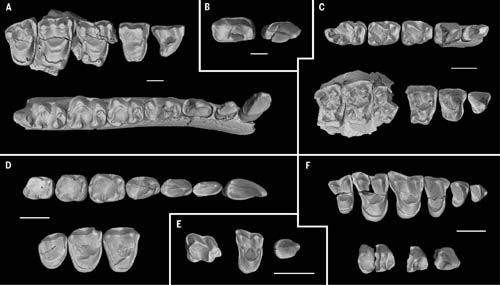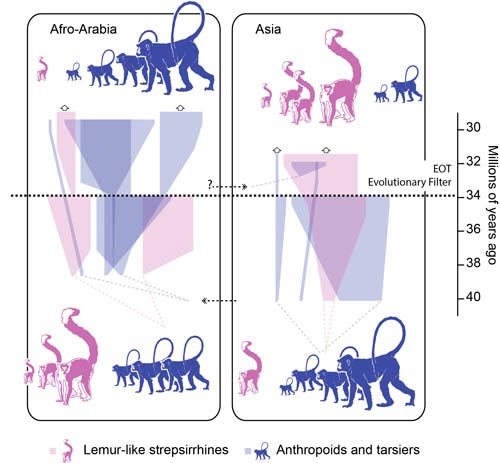Chinese Fossil Primates Unravel Evolutionary Puzzle
Ancient Asian Primates Decimated by Climate Change
The lineage of primates that led to the monkeys, the apes and eventually the hominins (that’s us), originated in Asia. Palaeoanthropologists and palaeontologists tend to agree on this as the known fossil record suggests a Far Eastern evolutionary heritage for our distant ancestors. However, there is a conundrum, if the anthropoids (those flat-faced monkeys that led to the apes and ourselves), evolved in Asia, then why didn’t this evolutionary line continue and lead to higher apes and hominins from Asia?
For models and figures of prehistoric animals: Prehistoric Animal Figures and Replicas.
Fossil Primates
The fossil record indicates that the earliest anthropoid fossils date from 45 million years ago (Asian fossil discoveries). In African strata some seven or eight million years younger, the first fossils of African anthropoids are found. We can conclude from this fossil evidence that the anthropoids first evolved in Asia, only making their way to Africa around 38 million years ago, with the hominins evolving something like 33 million years later, but only in Africa, so what caused the Asian anthropoids to stall?
Thanks to some remarkable fossil finds from China, scientists have solved this primate puzzle, it seems that dramatic climate change some 34 million years ago, nearly wiped out Asian primates, decimated populations and rendered much of that continent as “no go” areas for our distant cousins.
Ancient Teeth and Bones Provide an Important Breakthrough in Our Understanding of Primate Evolution

Different types of ancient primate from southern China identified from their fossilised jaws and teeth.
Picture credit: Chinese Academy of Sciences
Studying Fossil Primate Teeth
The picture above shows the different types of fossil teeth and jawbone used by the scientists to identify new species of Asian Oligocene primates.
In a study published in the journal “Science”, researchers from the University of Kansas in collaboration with colleagues from the Chinese Academy of Sciences, report on the identification of six new species of primates from a site in southern China. Described as a “mother lode”, these extremely rare and precious fossils shed light on how some Asian primates survived the global cooling event that marked the end of the Eocene Epoch.
Eocene to Oligocene Transition (EOT)
The end of the Eocene Epoch is marked by a significant extinction event. It may not have been as devastating as the end Cretaceous extinction that led to the demise of something like 70% of all large terrestrial animals, but nonetheless, there was a considerable amount of faunal turnover with many long-established genera (such as the early whales), becoming extinct. Some 34 million years ago, the Earth cooled dramatically. Global temperatures fell from an average of around 21 degrees Celsius to around 16 degrees Celsius.
Scientists remain uncertain as to the cause of the cooling, although there was considerable tectonic plate activity, volcanism and a number of extraterrestrial impacts during the Late Eocene. Some studies have indicated a fall in atmospheric carbon dioxide at this time. This “greenhouse gas”, so feared today, because of its affect on global warming, may have been reduced in the atmosphere to such an extent that the Earth entered a phase of dramatic cooling. It is at this time that Antarctica began to change into the frozen wasteland we know today.
The Impact of Global Cooling
As the Earth grew colder so the tropical forests shrank and the available habitat for Asian primates was greatly reduced, the six newly described species were part of an ecosystem that clung on in southern China, an area where a tropical climate still persisted.
Commenting on the significance of this decade long study, co-author of the scientific paper, K. Christopher Beard, (senior curator at the University of Kansas Biodiversity Institute) stated:
“Primates like it warm and wet, so they faced hard times around the world — to the extent that they went extinct in North America and Europe. Of course, primates somehow survived in Africa and southern Asia, because we’re still around to talk about it.”
The Key to Understanding the Evolution of Primates
As anthropoid primates first appeared in Asia, these new fossil discoveries help scientists to understand the fate of primates on that continent, which is fundamental to understanding early primate and ultimately ape evolution.
Senior curator Beard added:
“This has always been an enigma. We had a lot of evidence previously that the earliest anthropoids originated in Asia. At some point, later in the Eocene, these Asian anthropoids got to Africa and started to diversify there. At some point, the geographic focal point of anthropoid evolution — monkeys, apes and humans — shifted from Asia to Africa. But we never understood when and why. Now, we know. The Eocene-Oligocene climate crisis virtually wiped out Asian anthropoids, so the only place they could evolve to become later monkeys, apes and humans was Africa.”
Working with colleagues from the Chinese Academy of Sciences (Institute of Vertebrate Palaeontology and Palaeoanthropology), specifically Xijun Ni, Qiang Li and Lüzhou Li, the researchers were able to shift through the 34-million-year-old sediments to find teeth and jaw fragments that enabled them to erect six new species. The fossils were recovered from the upper part of the Caijiachong Formation, Yuezhou Basin, Yunnan Province, through a combination of careful site mapping and scree washing. It seems that whilst much of Asia became inhospitable for primates, this part of China retained tropical forest so a number of species ended up being crowded into a limited space.
A List of the Six New Species of Primate Named
- Yunnanadapis folivorus (pronounced You-nan-ah-dap-is) a member of the Strepsirrhini (lemurs). In the fossil teeth photograph above Y. folivorus is A.
- Yunnanadapis imperator (pronounced You-nan-ah-dap-is) a member of the Strepsirrhini (lemurs). In the fossil teeth photograph above Y. imperator is B.
- Laomaki yunnanensis (pronounced Lay-oh-ma-key) a lemur-like primate (Strepsirrhini). In the photograph of the fossil teeth above L. yunnanensis is C.
- Gatanthropus micros (pronounced Gat-anthro-pos) another lemur-like primate. In the fossil teeth picture above G. micros is D.
- Oligotarsius rarus (pronounced Olee-go-tar-see-us) the only member of the Tarsiidae (Tarsiers) described from this location. O. rarus is represented by E in the fossil teeth picture above.
- Bahinia banyueae (pronounced Ba-hin-nee-ah), the only anthropoid identified, superficially similar to today’s marmosets, represented by F in the fossil teeth photograph above.
Differences in Oligocene Primate Faunas
The team’s research suggests that the Eocene-Oligocene transition (EOT) led to completely different primate faunas in Asia compared to Africa and the Near East. In Africa, the anthropoid primates radiated, diversified and became dominant. However, in Asia, it was the lemur-like primates the Strepsirrhini that seem to have dominated. The EOT acted as an evolutionary filter dramatically altering the evolution of primates around the world.
The EOT Acted as an Evolutionary Filter Changing Primate Evolution
Picture credit: Chinese Academy of Sciences
The EOT changed the evolutionary history of the primates, acting as a filter. When the composition of early Oligocene primate faunas of Asia and Afro-Arabia are compared, we see that in Asia it was the lemur-like primates (Strepsirrhini) that rose to dominance, whereas in Afro-Arabia, the lemurs became much rarer and it was the anthropoid apes that diversified and became prominent.
The Rare Oligotarsius
Tarsier fossils are incredibly rare in the fossil record, and very little is known about the evolution of the Tarsiidae, the trivial name of O. rarus recognises this. The teeth of Oligotarsius are very similar to modern tarsiers found today in Indonesia and the Philippines. This suggests that extant tarsiers are little changed from their ancient ancestors.
Dr Beard explained:
“If you look back at the fossil record, we know that tarsiers once lived on mainland Asia, as far north as central China. The fossil teeth described in this paper are nearly identical to those of modern tarsiers. Research shows that modern tarsiers are pretty much living fossils, those things have been doing what they do ever since time immemorial, as far as we can tell.”
A Vulnerability of All Primates?
This new study underscores a vulnerability of perhaps, all primates, that is how they cope when there is dramatic climate change. The global cooling of the EOT altered primate evolution and transformed the primate faunal mixes of both Asia and Africa. The EOT is an opposite climate effect to what we are experiencing today. Thirty-four million years ago the world cooled, today people are very concerned about global warming, the key point is this, whether the climate warms or grows cold, primates seem to be more sensitive to a changing world than other mammals. This could mean very bad news for our own species.
Food for Thought
It is a sobering thought, but what if the Eocene-Oligocene cooling had not taken place? Asian anthropoids would have continued to evolve and diversify, potentially with far-reaching consequences for all primates, including hominins and our own species. Homo sapiens (that’s us), evolved in Africa some 220,000 years ago, however, had this ancient cooling not occurred, the outcome in terms of anthropoid and ultimately human evolution could have been very different.
For an article on potentially the oldest primate: The Oldest Primate To Date?
To read about Miocene Tarsiers from Thailand: Miocene Tarsier Fossils from Thailand.


